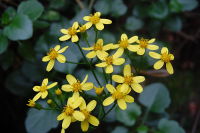Angiosperms
Overview
Angiosperms are the largest and most diverse plant group within the kingdom Plante. This plant group consists of over 300,000 flowering plants and makes up 80% of plants that are living today [1]. Angiosperms are defined by being vascular seed plants where the ovule (egg) is fertilized and then enclosed into a hollow ovary. These contrast with another group that exists in the kingdom Plante, gymnosperms in which seeds (fertilized ovule) are not enclosed within the ovary and are often exposed (the most common examples being conifers and their cones) [1]. Angiosperms are a group of seed plants, also known as spermatophytes [2].
Clades
Angiosperms are made up of three main clades. The first is a small basal relic clade which makes up a small percentage of the angiosperms. The two main clades that are most commonly discussed when talking about angiosperms are the monocots and the eudicots [2]. To differentiate between monocots and dicots, it is essential that we focus on the embryo morphology of the seed in its early growing stages, the stem vascular structure, and plastid protein inclusion [4].
Monocots

Monocotyledon, more commonly known as monocots, are one of the two major clades of angiosperms. This clade consists of around 60,000 species [3] many of which are some of the most economically important plant species such as Poaceae (true grasses), Orchidaceae (orchids), Lilaceae (lillies), and Arecaceae (palms) [3]. Monocots diverged early on from their dicot relatives early in the evolution of angiosperms. There are major characteristics that distinguish this clade of angiosperms from the other. The first, most telling characteristic are the small leaf-like structures on the embryo called the cotyledon [4]. Monocots have a single cotyledon, while other plants may have two. Another telling characteristic that is most commonly looked at when determining if an angiosperm is a monocot, is the vascular structure of the plant. The actactostele (the arrangement of vascular strands in the stem) is spread throughout the stem and is most concentrated at the periphery [4].
Eudicots

One of the largest groups of eudicots is the rosids (roses). Eudicots commonly have a repetitive flower structure that contains 5 sepals, 5 petals, 2 whorls of 5 stamen, and 3 or 5 fused carpels [5]. There are around 83,000 species in this group of angiosperms that we have discovered thus far. There is a rather large group within the rosids that are very economically and agriculturally important; it is termed the "nitrogen fixing clade" which consists of legumes, roses, apples, squashes, oaks, walnuts and many more [5]. Leaves of eudicots are usually characterized by netted venation (unlike monocots who have straight leaves and vascular structure) [6]. These netted vascular structures are either pinnate or palmate. Vascular structures and bundles are usually bundled around the pith and eudicots usually have 2 cotyledons instead of just one like a monocot [6].
References
[1] Angiosperm - an overview | ScienceDirect Topics. https://www.sciencedirect.com/topics/biochemistry-genetics-and-molecular-biology/angiosperm.
[2] angiosperm | Description, Evolution, Characteristics, & Taxonomy. https://www.britannica.com/plant/angiosperm.
[3] Monocotyledon | plant. https://www.britannica.com/plant/monocotyledon.
[4] More on Morphology of the Monocots. https://ucmp.berkeley.edu/monocots/monocotmm.html.
[5] Stevens, P. F. 2016. Angiosperm Phylogeny and Diversification. Pages 78–83 in R. M. Kliman, editor. Encyclopedia of Evolutionary Biology. Academic Press, Oxford.
[6] Eudicot characteristics. https://james-vankley.com/PineywoodsPlants/groupkey/key_eudicotyledons.html.